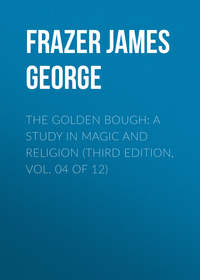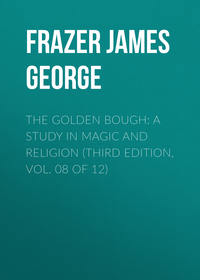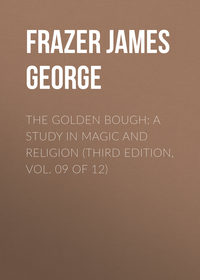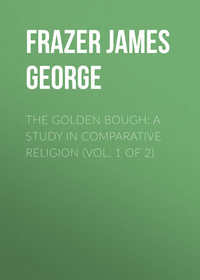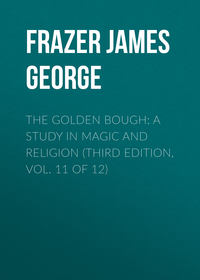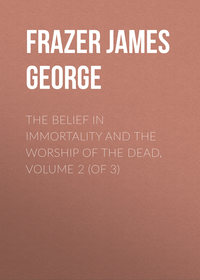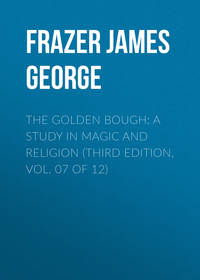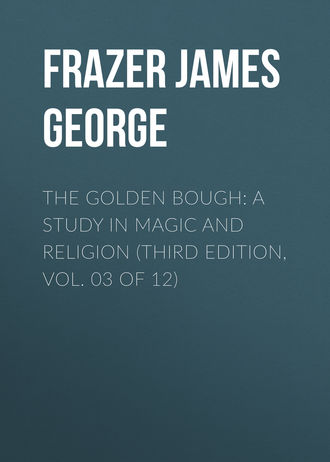 полная версия
полная версияThe Golden Bough: A Study in Magic and Religion (Third Edition, Vol. 03 of 12)
Examples of the fatal effects of imagination in other parts of the world.
Thus in the Polynesian race, to which the Maoris belong, superstition erected round the persons of sacred chiefs a real, though at the same time purely imaginary barrier, to transgress which actually entailed the death of the transgressor whenever he became aware of what he had done. This fatal power of the imagination working through superstitious terrors is by no means confined to one race; it appears to be common among savages. For example, among the aborigines of Australia a native will die after the infliction of even the most superficial wound if only he believes that the weapon which inflicted the wound had been sung over and thus endowed with magical virtue. He simply lies down, refuses food, and pines away.495 Similarly among some of the Indian tribes of Brazil, if the medicine-man predicted the death of any one who had offended him, “the wretch took to his hammock instantly in such full expectation of dying, that he would neither eat nor drink, and the prediction was a sentence which faith effectually executed.”496 Speaking of certain African races Major Leonard observes: “I have seen more than one hardened old Haussa soldier dying steadily and by inches, because he believed himself to be bewitched; so that no nourishment or medicines that were given to him had the slightest effect either to check the mischief or to improve his condition in any way, and nothing was able to divert him from a fate which he considered inevitable. In the same way, and under very similar conditions, I have seen Kru-men and others die, in spite of every effort that was made to save them, simply because they had made up their minds, not (as we thought at the time) to die, but that being in the clutch of malignant demons they were bound to die.”497 The Capuchin missionary Merolla da Sorrento, who travelled in the West African kingdom of Congo in the latter part of the seventeenth century, has described a remarkable case of death wrought purely by superstitious fear. He says: “It is a custom that either the parents or the wizards give certain rules to be inviolably observed by the young people, and which they call chegilla: these are to abstain from eating either some sorts of poultry, the flesh of some kinds of wild beasts, such and such fruits, roots either raw or boiled after this or another manner, with several other ridiculous injunctions of the like nature, too many to be enumerated here. You would wonder with what religious observance these commands are obeyed. These young people would sooner chuse to fast several days together, than to taste the least bit of what has been forbidden them; and if it sometimes happen that the chegilla has been neglected to have been given them by their parents, they think they shall presently die unless they go immediately to receive it from the wizards. A certain young negro, being upon a journey, lodged in a friend's house by the way: his friend, before he went out the next morning, had got a wild hen ready for his breakfast, they being much better than the tame ones. The negro hereupon demanded, ‘If it were a wild hen?’ His host answered, ‘No’: then he fell on heartily, and afterwards proceeded on his journey. About four years after these two met together again, and the aforesaid negro being not yet married, his old friend asked him, ‘If he would eat a wild hen?’ To which he answered, ‘That he had received the chegilla, and therefore could not.’ Hereat the host began immediately to laugh, enquiring of him, ‘What made him refuse it now, when he had eaten one at his table about four years ago?’ At the hearing of this the negro immediately fell a trembling, and suffered himself to be so far possessed with the effects of imagination, that he died in less than twenty-four hours after.”498
§ 2. Mourners tabooed
The taboos observed by sacred kings resemble those imposed on persons who are commonly regarded as unclean, such as menstruous women, homicides, and so forth. Taboos laid on persons who have been in contact with the dead in New Zealand.
Thus regarding his sacred chiefs and kings as charged with a mysterious spiritual force which so to say explodes at contact, the savage naturally ranks them among the dangerous classes of society, and imposes upon them the same sort of restraints that he lays on manslayers, menstruous women, and other persons whom he looks upon with a certain fear and horror. For example, sacred kings and priests in Polynesia were not allowed to touch food with their hands, and had therefore to be fed by others;499 and as we have just seen, their vessels, garments, and other property might not be used by others on pain of disease and death. Now precisely the same observances are exacted by some savages from girls at their first menstruation, women after childbirth, homicides, mourners, and all persons who have come into contact with the dead. Thus, for example, to begin with the last class of persons, among the Maoris any one who had handled a corpse, helped to convey it to the grave, or touched a dead man's bones, was cut off from all intercourse and almost all communication with mankind. He could not enter any house, or come into contact with any person or thing, without utterly bedevilling them. He might not even touch food with his hands, which had become so frightfully tabooed or unclean as to be quite useless. Food would be set for him on the ground, and he would then sit or kneel down, and, with his hands carefully held behind his back, would gnaw at it as best he could. In some cases he would be fed by another person, who with outstretched arm contrived to do it without touching the tabooed man; but the feeder was himself subjected to many severe restrictions, little less onerous than those which were imposed upon the other. In almost every populous village there lived a degraded wretch, the lowest of the low, who earned a sorry pittance by thus waiting upon the defiled. Clad in rags, daubed from head to foot with red ochre and stinking shark oil, always solitary and silent, generally old, haggard, and wizened, often half crazed, he might be seen sitting motionless all day apart from the common path or thoroughfare of the village, gazing with lack-lustre eyes on the busy doings in which he might never take a part. Twice a day a dole of food would be thrown on the ground before him to munch as well as he could without the use of his hands; and at night, huddling his greasy tatters about him, he would crawl into some miserable lair of leaves and refuse, where, dirty, cold, and hungry, he passed, in broken ghost-haunted slumbers, a wretched night as a prelude to another wretched day. Such was the only human being deemed fit to associate at arm's length with one who had paid the last offices of respect and friendship to the dead. And when, the dismal term of his seclusion being over, the mourner was about to mix with his fellows once more, all the dishes he had used in his seclusion were diligently smashed, and all the garments he had worn were carefully thrown away, lest they should spread the contagion of his defilement among others,500 just as the vessels and clothes of sacred kings and chiefs are destroyed or cast away for a similar reason. So complete in these respects is the analogy which the savage traces between the spiritual influences that emanate from divinities and from the dead, between the odour of sanctity and the stench of corruption.
The rule which forbids persons who have been in contact with a corpse to touch food with their hands seems to have been universal in Polynesia. A rule of the same sort is observed in Melanesia and Africa.
The rule which forbids persons who have been in contact with the dead to touch food with their hands would seem to have been universal in Polynesia. Thus in Samoa “those who attended the deceased were most careful not to handle food, and for days were fed by others as if they were helpless infants. Baldness and the loss of teeth were supposed to be the punishment inflicted by the household god if they violated the rule.”501 Again, in Tonga, “no person can touch a dead chief without being taboo'd for ten lunar months, except chiefs, who are only taboo'd for three, four, or five months, according to the superiority of the dead chief; except again it be the body of Tooitonga [the great divine chief], and then even the greatest chief would be taboo'd ten months, as was the case with Finow's wife above mentioned. During the time a man is taboo'd he must not feed himself with his own hands, but must be fed by somebody else: he must not even use a toothpick himself, but must guide another person's hand holding the toothpick. If he is hungry and there is no one to feed him, he must go down upon his hands and knees, and pick up his victuals with his mouth: and if he infringes upon any of these rules, it is firmly expected that he will swell up and die: and this belief is so strong that Mr. Mariner thinks no native ever made an experiment to prove the contrary. They often saw him feed himself with his hands after having touched dead chiefs, and not observing his health to decline, they attributed it to his being a foreigner, and being governed by different gods.”502 Again, in Wallis Island “contact with a corpse subjects the hands to the law of taboo till they are washed, which is not done for several weeks. Until that purification has taken place, the tabooed persons may not themselves put food to their mouths; other people render them that service.”503 A rule of the same sort is or was observed in various parts of Melanesia. Thus in Fiji the taboo for handling a dead chief lasted from one to ten months according to his rank; for a commoner it lasted not more than four days. It was commonly resorted to by the lazy and idle; for during the time of their seclusion they were not only provided with food, but were actually fed by attendants or ate their food from the ground.504 Similarly in the Motu tribe of New Guinea a man is tabooed, generally for three days, after handling a corpse, and while the taboo lasts he may not touch food with his hands. At the end of the time he bathes and the taboo is over.505 So in New Caledonia the two men who are charged with the duty of burying and guarding a corpse have to remain in seclusion and observe a number of rules of abstinence. They live apart from their wives. They may not shave or cut their hair. Their food is laid for them on leaves and they take it up with their mouth or a stick; but oftener an attendant feeds them, just as he might feed a man whose limbs were palsied.506 So among the Nandi of British East Africa persons who have handled a corpse bathe in a river, anoint their bodies with fat, partially shave their heads, and live in the hut of the deceased for four days. All these days they may not be seen by boys or women: they may not drink milk; and they may not touch food with their hands, but must eat it with the help of a potsherd or chip of a gourd.507 Similarly in the Ba-Pedi and Ba-Thonga tribes of South Africa men who have dug a grave may not touch food with their fingers till the rites of their purification are accomplished; meantime they eat with the help of special spoons. If they broke this rule, it is thought that they would be consumptive.508 So in the Ngarigo tribe of New South Wales a novice who has just passed through the ceremony of initiation has to go away to the mountains and stay there for a while, sometimes for more than six months, under the charge of one or more old men; and all the time of his absence among the mountains he may not touch cooked food with his hands; the food is put into his mouth by the man who looks after him.509
Taboos laid on mourners among the Indian tribes of North America.
Among the Shuswap of British Columbia widows and widowers in mourning are secluded and forbidden to touch their own head or body; the cups and cooking-vessels which they use may be used by no one else. They must build a sweat-house beside a creek, sweat there all night and bathe regularly, after which they must rub their bodies with branches of spruce. The branches may not be used more than once, and when they have served their purpose they are stuck into the ground all round the hut. No hunter would come near such mourners, for their presence is unlucky. If their shadow were to fall on any one, he would be taken ill at once. They employ thorn bushes for bed and pillow, in order to keep away the ghost of the deceased; and thorn bushes are also laid all around their beds.510 This last precaution shews clearly what the spiritual danger is which leads to the exclusion of such persons from ordinary society; it is simply a fear of the ghost who is supposed to be hovering near them. Among the Thompson Indians of British Columbia the persons who handled a corpse and dug the grave were secluded for four days. They fasted until the body was buried, after which they were given food apart from the other people. They would not touch the food with their hands, but must put it into their mouths with sharp-pointed sticks. They ate off a small mat, and drank out of birch-bark cups, which, together with the mat, were thrown away at the end of the four days. The first four mouthfuls of food, as well as of water, had to be spit into the fire. During their seclusion they bathed in a stream and might not sleep with their wives. Widows and widowers were obliged to observe rules of a similar kind. Immediately after the death they went out and passed through a patch of rose-bushes four times, probably in order to rid themselves of the ghost, who might be supposed to stick on a thorn. For a year they had to sleep on a bed of fir-boughs, on which sticks of rose-bushes were laid; many wore twigs of rose-bush and juniper in a piece of buckskin on their persons. The first four days they might not touch their food, but ate with sharp-pointed sticks and spat out the first four mouthfuls of each meal, and the first four of water, into the fire. A widower might not fish at another man's fishing-place or with another man's net; if he did, it would make the place and the net useless for the season. If he transplanted a trout into another lake, before releasing it he blew on the head of the fish, and after chewing deer-fat, he spat some of the grease on its head in order to remove the baneful effect of his touch. Then he let the trout go, bidding it farewell, and asking it to propagate its kind in plenty. Any grass or branches that a widow or widower sat or lay down on withered up. If a widow should break sticks or boughs, her hands or arms would also break. She might not pick berries for a year, else the whole crop of berries would fall off the bushes or wither up. She might not cook food or fetch water for her children, nor let them lie down on her bed, nor should she lie or sit where they slept. Sometimes a widow would wear a breech-cloth made of dry bunch-grass for several days to prevent her husband's ghost from having intercourse with her.511 Among the Tinneh or Déné Indians of North-West America all who have handled a corpse are subject to many restrictions and taboos. They are debarred for a certain period from eating any fresh meat: they may never use a knife to cut their food but must tear it with their teeth: they may not drink out of a vessel in common use, but must employ a gourd which they carry about for the purpose; and they wear peeled willow wands about their arms and necks or carry them in their hands as disinfectants to annul the evil consequences which are supposed to follow from handling the dead.512 Among the Indian tribes of Queen Charlotte Sound a widow or widower goes into special mourning for a month; among the Koskimos the period of mourning is four months. During this time he or she lives apart in a very small hut behind the house, eating and drinking alone, and using for that purpose dishes which are not employed by other members of the tribe.513
Seclusion of widows and widowers in the Philippines and New Guinea.
Among the Agutainos, who inhabit Palawan, one of the Philippine Islands, a widow may not leave her hut for seven or eight days after the death; and even then she may only go out at an hour when she is not likely to meet anybody, for whoever looks upon her dies a sudden death. To prevent this fatal catastrophe, the widow knocks with a wooden peg on the trees as she goes along, thus warning people of her dangerous proximity; and the very trees on which she knocks soon die.514 So poisonous is the atmosphere of death that surrounds those to whom the ghost of the departed may be thought to cleave. In the Mekeo district of British New Guinea a widower loses all his civil rights and becomes a social outcast, an object of fear and horror, shunned by all. He may not cultivate a garden, nor shew himself in public, nor traverse the village, nor walk on the roads and paths. Like a wild beast he must skulk in the long grass and the bushes; and if he sees or hears any one coming, especially a woman, he must hide behind a tree or a thicket. If he wishes to fish or hunt, he must do it alone and at night. If he would consult any one, even the missionary, he does so by stealth and at night; he seems to have lost his voice and speaks only in whispers. Were he to join a party of fishers or hunters, his presence would bring misfortune on them; the ghost of his dead wife would frighten away the fish or the game. He goes about everywhere and at all times armed with a tomahawk to defend himself, not only against wild boars in the jungle, but against the dreaded spirit of his departed spouse, who would do him an ill turn if she could; for all the souls of the dead are malignant and their only delight is to harm the living.515
§ 3. Women tabooed at Menstruation and Childbirth
Taboos imposed on women at menstruation.
In general, we may say that the prohibition to use the vessels, garments, and so on of certain persons, and the effects supposed to follow an infraction of the rule, are exactly the same whether the persons to whom the things belong are sacred or what we might call unclean and polluted. As the garments which have been touched by a sacred chief kill those who handle them, so do the things which have been touched by a menstruous woman. An Australian blackfellow, who discovered that his wife had lain on his blanket at her menstrual period, killed her and died of terror himself within a fortnight.516 Hence Australian women at these times are forbidden under pain of death to touch anything that men use, or even to walk on a path that any man frequents. They are also secluded at childbirth, and all vessels used by them during their seclusion are burned.517 In Uganda the pots which a woman touches while the impurity of childbirth or of menstruation is on her should be destroyed; spears and shields defiled by her touch are not destroyed but only purified.518 No Esquimaux of Alaska will willingly drink out of the same cup or eat out of the same dish that has been used by a woman at her confinement until it has been purified by certain incantations.519 Amongst some of the Indians of North America, women at menstruation are forbidden to touch men's utensils, which would be so defiled by their touch that their subsequent use would be attended by certain mischief or misfortune.520 For instance, in some of the Tinneh or Déné tribes girls verging on maturity take care that the dishes out of which they eat are used by no one else. When their first periodical sickness comes on, they are fed by their mothers or nearest kinswomen, and will on no account touch their food with their own hands. At the same time they abstain from touching their heads with their hands, and keep a small stick to scratch their heads with when they itch. They remain outside the house in a hut built for the purpose, and wear a skull-cap made of skin to fit very tight, which they never lay aside till the first monthly infirmity is over. A fringe of shells, bones, and so on hangs down from their forehead so as to cover their eyes, lest any malicious sorcerer should harm them during this critical period.521 “Among all the Déné and most other American tribes, hardly any other being was the object of so much dread as a menstruating woman. As soon as signs of that condition made themselves apparent in a young girl she was carefully segregated from all but female company, and had to live by herself in a small hut away from the gaze of the villagers or of the male members of the roving band. While in that awful state, she had to abstain from touching anything belonging to man, or the spoils of any venison or other animal, lest she would thereby pollute the same, and condemn the hunters to failure, owing to the anger of the game thus slighted. Dried fish formed her diet, and cold water, absorbed through a drinking tube, was her only beverage. Moreover, as the very sight of her was dangerous to society, a special skin bonnet, with fringes falling over her face down to her breast, hid her from the public gaze, even some time after she had recovered her normal state.”522 Among the Bribri Indians of Costa Rica a menstruous woman is regarded as unclean (bukuru). The only plates she may use for her food are banana leaves, which, when she has done with them, she throws away in some sequestered spot; for were a cow to find them and eat them, the animal would waste away and perish. And she drinks out of a special vessel for a like reason; because if any one drank out of the same cup after her, he would surely die.523 In the islands of Mabuiag and Saibai, in Torres Straits, girls at their first menstruation are strictly secluded from the sight of men. In Mabuiag the seclusion lasts three months, in Saibai about a fortnight. During the time of her separation the girl is forbidden to feed herself or to handle food, which is put into her mouth by women or girls told off to wait on her.524
Taboos imposed on women in childbed.
Among many peoples similar restrictions are imposed on women in childbed and apparently for similar reasons; at such periods women are supposed to be in a dangerous condition which would infect any person or thing they might touch; hence they are put into quarantine until, with the recovery of their health and strength, the imaginary danger has passed away. Thus, in Tahiti a woman after childbirth was secluded for a fortnight or three weeks in a temporary hut erected on sacred ground; during the time of her seclusion she was debarred from touching provisions, and had to be fed by another. Further, if any one else touched the child at this period, he was subjected to the same restrictions as the mother until the ceremony of her purification had been performed.525 Similarly in Manahiki, an island of the Southern Pacific, for ten days after her delivery a woman was not allowed to handle food, and had to be fed by some other person.526 In the Sinaugolo tribe of British New Guinea, for about a month after her confinement a woman may not prepare or handle food; she may not even cook for herself, and when she is eating the food made ready for her by her friends she must use a sharpened stick to transfer it to her mouth.527 Similarly in the Roro and Mekeo districts of British New Guinea a woman after childbirth becomes for a time taboo (opu), and any person or thing she may chance to touch becomes taboo also. Accordingly during this time she abstains from cooking; for were she to cook food, not only the victuals themselves but the pot and the fire would be tabooed, so that nobody could eat the victuals, or use the pot, or warm himself at the fire. Further at meals she may not dip her hand into the dish and help herself, as the natives commonly do; she must use for the purpose a long fork, with which she takes up the bananas, sweet potatoes, yams, and so forth, in order not to contaminate the rest of the food in the vessel by the touch of her fingers. If she wishes to drink, a gourd is set before her, and wrapping up her hands in a cloth or coco-nut fibre she pours the water into a small calabash for her use; or she may pour the water directly into her mouth without letting the gourd touch her lips. If anything has to be handed to her, it is not given from hand to hand but reached to her at the end of a long stick.528 Similarly in the island of Kadiak, off Alaska, a woman about to be delivered retires to a miserable low hovel built of reeds, where she must remain for twenty days after the birth of her child, whatever the season may be, and she is considered so unclean that no one will touch her, and food is reached to her on sticks.529 In the Ba-Pedi and Ba-Thonga tribes of South Africa a woman in childbed may not touch her food with her hands all the time of her seclusion; she must eat with the help of a wooden spoon. They think that if she touched her victuals she might infect them with her bloody flux, and that having partaken of such tainted food she would fall into a consumption.530 The Bribri Indians regard the pollution of childbed as much more dangerous even than that of menstruation. When a woman feels her time approaching, she informs her husband, who makes haste to build a hut for her in a lonely spot. There she must live alone, holding no converse with anybody save her mother or another woman. After her delivery the medicine-man purifies her by breathing on her and laying an animal, it matters not what, upon her. But even this ceremony only mitigates her uncleanness into a state considered to be equivalent to that of a menstruous woman; and for a full lunar month she must live apart from her housemates, observing the same rules with regard to eating and drinking as at her monthly periods. The case is still worse, the pollution is still more deadly, if she has had a miscarriage or has been delivered of a stillborn child. In that case she may not go near a living soul: the mere contact with things she has used is exceedingly dangerous: her food is handed to her at the end of a long stick. This lasts generally for three weeks, after which she may go home subject only to the restrictions incident to an ordinary confinement.531 Among the Adivi or forest Gollas of Southern India, when a woman feels the first pains of labour, she is turned clean out of the village and must take up her quarters in a little hut made of leaves or mats about two hundred yards away. In this hut she must bring forth her offspring unaided, unless a midwife can be fetched in time to be with her before the child is born; if the midwife arrives after the birth has taken place she may not go near the woman. For ninety days the mother lives in the hut by herself. If any one touches her, he or she becomes, like the mother herself, an outcast and is expelled from the village for three months, The woman's husband generally makes a little hut about fifty yards from hers and stays in it sometimes to watch over her, but he may not go near her on pain of being an outcast for three months. Food is placed on the ground near the woman's hut and she takes it. On the fourth day after the birth a woman of the village goes to her and pours water on her, but may not come into contact with her. On the fifth day the villagers clear away the stones and thorny bushes from a patch of ground about ten yards on the village side of the hut, and to this clearing the woman removes her hut unaided; no one may help her to do so. On the ninth, fifteenth, and thirtieth days she again shifts her hut nearer and nearer to the village; and again once in each of the two following months she brings her hut still nearer. On the ninetieth day of her seclusion the woman is called out from her hut, washed, clad in clean clothes, and after being taken to the village temple is conducted to her own house by a man of the caste, who performs purificatory ceremonies.532




